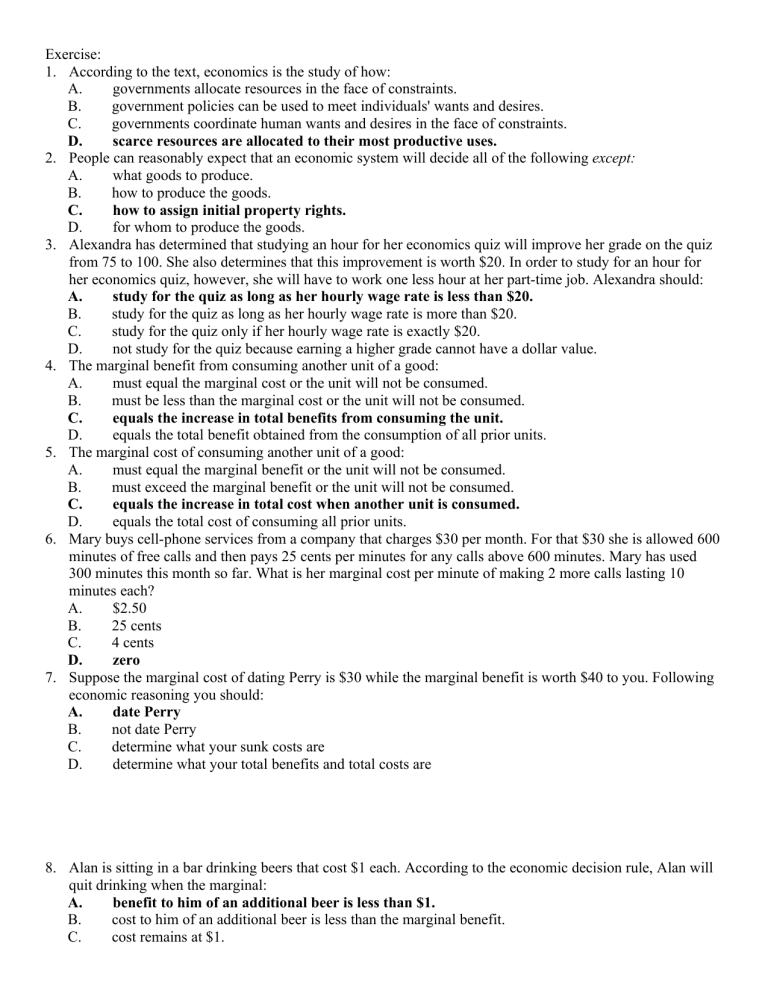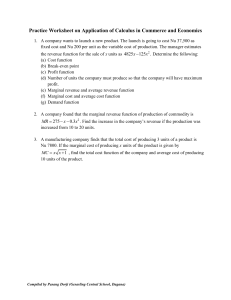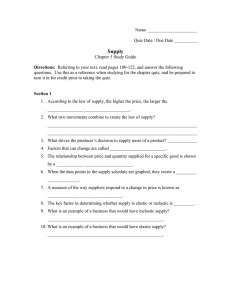
Exercise: 1. According to the text, economics is the study of how: A. governments allocate resources in the face of constraints. B. government policies can be used to meet individuals' wants and desires. C. governments coordinate human wants and desires in the face of constraints. D. scarce resources are allocated to their most productive uses. 2. People can reasonably expect that an economic system will decide all of the following except: A. what goods to produce. B. how to produce the goods. C. how to assign initial property rights. D. for whom to produce the goods. 3. Alexandra has determined that studying an hour for her economics quiz will improve her grade on the quiz from 75 to 100. She also determines that this improvement is worth $20. In order to study for an hour for her economics quiz, however, she will have to work one less hour at her part-time job. Alexandra should: A. study for the quiz as long as her hourly wage rate is less than $20. B. study for the quiz as long as her hourly wage rate is more than $20. C. study for the quiz only if her hourly wage rate is exactly $20. D. not study for the quiz because earning a higher grade cannot have a dollar value. 4. The marginal benefit from consuming another unit of a good: A. must equal the marginal cost or the unit will not be consumed. B. must be less than the marginal cost or the unit will not be consumed. C. equals the increase in total benefits from consuming the unit. D. equals the total benefit obtained from the consumption of all prior units. 5. The marginal cost of consuming another unit of a good: A. must equal the marginal benefit or the unit will not be consumed. B. must exceed the marginal benefit or the unit will not be consumed. C. equals the increase in total cost when another unit is consumed. D. equals the total cost of consuming all prior units. 6. Mary buys cell-phone services from a company that charges $30 per month. For that $30 she is allowed 600 minutes of free calls and then pays 25 cents per minutes for any calls above 600 minutes. Mary has used 300 minutes this month so far. What is her marginal cost per minute of making 2 more calls lasting 10 minutes each? A. $2.50 B. 25 cents C. 4 cents D. zero 7. Suppose the marginal cost of dating Perry is $30 while the marginal benefit is worth $40 to you. Following economic reasoning you should: A. date Perry B. not date Perry C. determine what your sunk costs are D. determine what your total benefits and total costs are 8. Alan is sitting in a bar drinking beers that cost $1 each. According to the economic decision rule, Alan will quit drinking when the marginal: A. benefit to him of an additional beer is less than $1. B. cost to him of an additional beer is less than the marginal benefit. C. cost remains at $1. D. benefit to him of an additional beer is greater than $1. 9. In 2004 Cambridge (UK) Evening News reported that more than 10,000 visitors waited up to 2 hours in line to see the rare flower, Titan Arum, at the Cambridge Botanical Gardens. Economists consider the two-hour waiting time part of the: A. marginal benefit of viewing the flower. B. sunk costs of viewing the flower. C. invisible hand. D. opportunity cost of viewing the flower. 10. Opportunity cost: A. includes only monetary outlays. B. is the net benefit foregone by not undertaking the next best alternative. C. is nonexistent for some choices. D. is the same as sunk cost. 11. When your wages rise the: A. opportunity cost of an hour of work decreases. B. opportunity cost of an hour of leisure stays the same. C. cost of working increases. D. opportunity cost of an hour of leisure increases. 12. If it takes you an hour to make a rational decision, and the opportunity cost of that hour is $100, then you will: A. always make rational decisions. B. make rational decisions only if the benefit from doing so exceeds $100. C. make rational decisions only if the benefit from doing so is less than $100. D. never make rational decisions. 13. The price mechanism that guides our actions is called the: A. invisible market force. B. invisible hand. C. invisible handshake. D. invisible foot. 14. Which of the following cannot be determined using a production possibility table? A. What combination of outputs can be produced. B. How much less of one output can be produced if more of another output is produced. C. What combination of outputs is best. D. How much output can be produced from a given level of inputs. W ar g o o d s ( “g u n s”) d b c a C iv ilia n g o o d s ( “ b u tte r ” ) 15. Refer to the above production possibilities curve. At the onset of the Second World War the United States had large amounts of idle human and property resources. Its economic adjustment from peacetime to wartime can best be described by the movement from point: A. B. C. W ar g o o d s ( “g u n s”) D. c to point b. a to point b. b to point c. c to point d.. d b a c C iv ilia n g o o d s ( “ b u tte r ” ) 16. Refer to the graph above. Given the production possibility curve, which point is unattainable? A. a. B. b. C. c. D. d. 17. Hans and John are identical workers who do exactly the same jobs, but in different countries. Hans earns 10 euros per hour in Germany while John earns 10 dollars per hour in the U.S. In which country are labor costs higher? A. They are the same in both. B. In the U.S. C. In Germany. D. One cannot tell without an exchange rate to compare euros and dollars. 18. Which of the following is most likely an action that supports competition? A. Requiring professionals, such as architects and engineers, to be licensed. B. Using tariffs to restrict the ability of foreign firms to sell products in domestic markets. C. Preventing two dominant firms in the same market from merging. D. Granting subsidies to farmers based on production levels. 19. Which of the following would most likely generate a positive externality? A. Roller coaster rides. B. Pollution. C. Alcoholic beverages. D. Education. 20. What kind of relationship exists between the price of gas and the quantity demanded for gas if the quantity demanded for gas falls when the price of gas increases? A. direct. B. inverse. C. normal. D. perverse. 21. An inverse relationship occurs between two variables when as one goes: A. up the other goes up. B. up the other goes down. C. up the other does not change. D. down the other goes down. 22. If the quantity demanded for a good rises as the price falls, then the curve representing this relationship will be: A. upward sloping. B. downward sloping. C. horizontal. D. cannot be determined.







